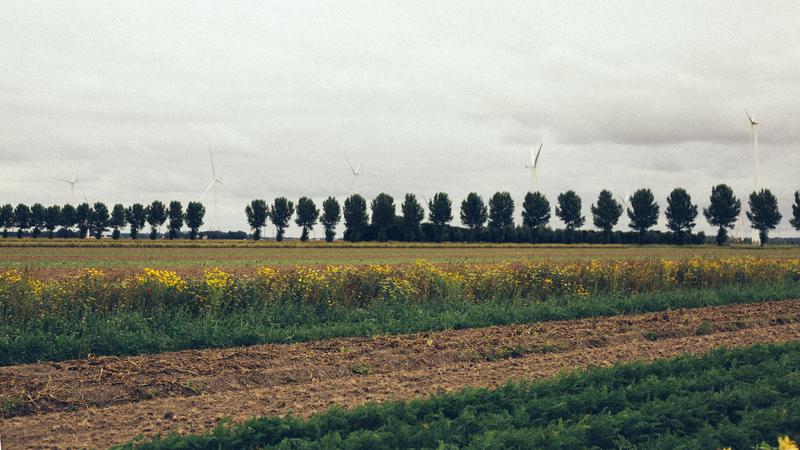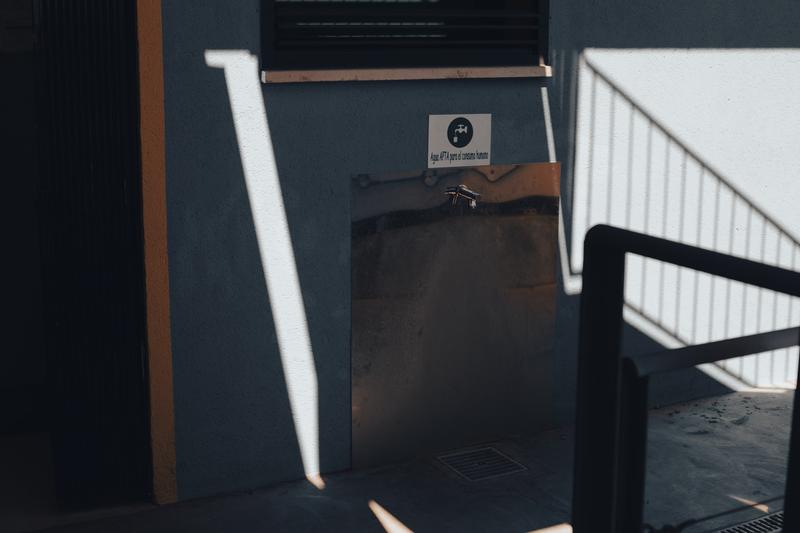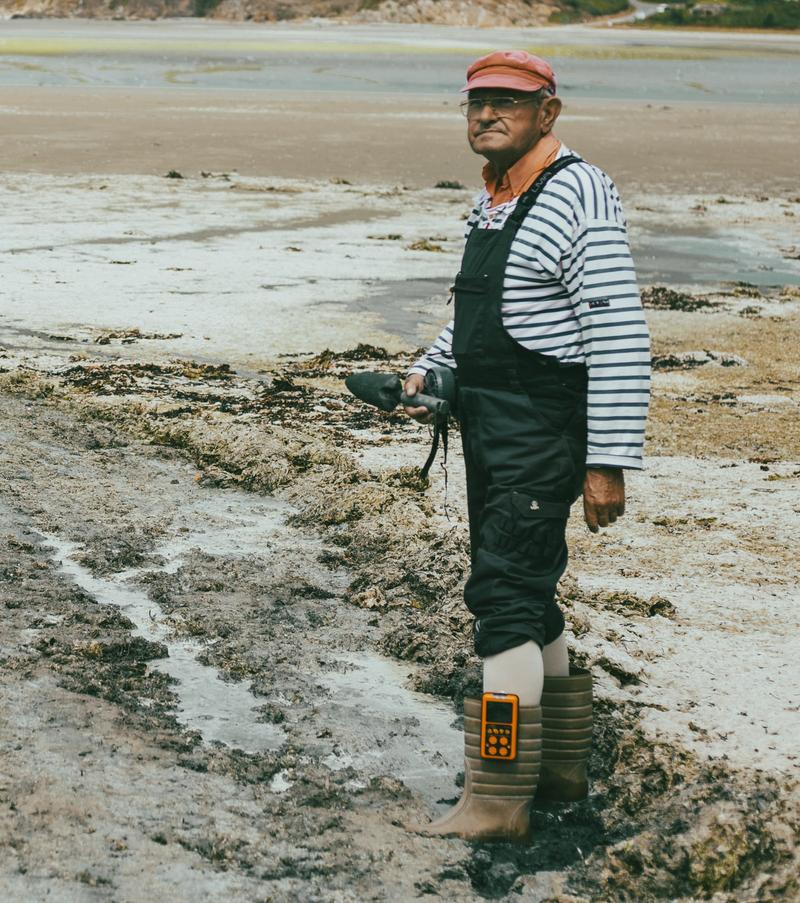Smelly algae and tap water bans
Nitrate water pollution is a threat to aquatic ecosystems and people's health

Cristina de Vega Martín never gets tired of the view from her balcony: long patches of green and yellow fields fading to give space to the bluish mountain mass of the Pyrenees. The view is one of the perks of living in the village of Banastás, two kilometres outside of the regional centre Huesca, in northeastern Spain. Among other advantages, de Vega Martín lists calm, spacious housing, and knowing your neighbours. But sometimes, when she cannot air her house because of the smell of slurry, a smell that sticks to her clothes and sticks to the furniture, she regrets living there. And then, there’s the water issue.
In late June 2022, a prolonged dry spell, during which temperatures never dropped below 30 °C, dried out the country's rivers and turned the vegetation yellow. But in Banastás, a village of fewer than 300 inhabitants, the contamination of drinking water with nitrates has been an issue for years. The local authorities have set up a tap in the centre of the village, next to the municipal swimming pool. “This is not practical at all. We buy bottled water to drink. But if I want to make a salad, I need to wash my vegetables. I need water for cooking, which means that I need to come here with demijohns every time I need something. We just end up buying water for everything,” de Vega Martín says. De Vega Martín is a teacher and a member of the citizens’ organisation HoyaHuescaViva (which translates roughly as “for a lively valley of Huesca”), which keeps tabs on the nitrate pollution in the region. In 2021, the levels of nitrates were reaching up to 140 mg/L.

Nitrates are useful nutrients used in both synthetic and organic (animal manure) fertilisers. But today’s factory farming results in a surplus of manure, which is mainly spread in the areas surrounding the farms, as long-distance transportation isn’t profitable, and the nutrients that are not taken up by plants can end up leaching into both groundwater and surface water streams.
And there is no lack of animal manure around Banastás. The village is located in the province of Aragon, which leads the country in terms of the number of pig herds, with six pigs per inhabitant. According to the data for 2021, obtained from the regional government of Aragon, the number of pigs in Huesca was 5,029,745 (and 9,874,722 in Aragon, for a population of 224,264), while in the valley of Huesca, there were 488 macro pork farms, with a capacity of 1,337,564 pigs in an area with fewer than 70,000 people. Spain is today one of the largest exporters of pig meat in Europe, and in 2020 was Europe’s number 1 pig meat exporter to China.
The EU’s Nitrates Directive, adopted in 1991, aims to protect water quality by preventing nitrates from agricultural sources from polluting water sources, and by promoting the use of good farming practices. In so-called Nitrate Vulnerable Zones – areas designated as being at risk of nitrate pollution from agricultural sources – mineral fertiliser application is limited and the maximum permissible amount of animal manure is limited to 170 kg nitrogen per hectare per year. In Spain, the area around Huesca is designated as a Nitrate Vulnerable Zone.
An excess of nutrients in water bodies can cause an overgrowth of algae, eventually leading to eutrophication, a reduction in the amount of oxygen in water bodies caused by an increase in nutrients, which is detrimental to the normal development of aquatic species. If the pollution reaches a certain critical mass, water bodies can become completely devoid of life, making it impossible to use them for swimming or as sources of drinking water.
Consumption of drinking water contaminated with nitrates can have adverse effects on people’s health, such as cyanosis, a blueish skin condition particularly dangerous for infants and pregnant women. A nationwide population-based cohort study in Denmark found a statistically significantly increased risk of colorectal cancer associated with nitrate levels above 3.87 mg/L in drinking water, which is well below the current (EU) drinking water standard of 50 mg/L. Another Danish study observed an association between nitrate and childhood nervous system cancers.
The Spanish data-driven investigative newsroom Datadista, which analysed the impact of the country’s intensive agriculture on both the quality and quantity of its aquifers, revealed that 70 % of the municipalities in Spain that have experienced nitrate contamination in tap water were located in areas vulnerable to nitrates of agricultural origin.
According to the Spain National Drinking Water Information System (SINAC), which compiles data analysing water for human consumption and the substances found in it, in 2021, over 700 of the samples analysed across the country exceeded the legal threshold of nitrates in water (50 mg/L) established by the European Drinking Water Directive.
Nutrients:
Nitrogen and phosphorus
Nitrogen and phosphorus are essential nutrients for plant growth, and key ingredients of man-made fertilisers. A surplus of nitrogen can result in air pollution (via nitrous oxide or ammonia) and pollution of groundwater with nitrates. Phosphorous can pollute waters and speed up the eutrophication of rivers and lakes.
Soil erosion is a major contributor of phosphorus to streams, because it adheres to soil particles; therefore, stopping erosion would contribute to decreasing the contamination of water by phosphorous. But nitrogen is highly mobile and can easily leach with water, thus entering groundwater.
“With regard to the procedures for incidents (control, corrective and/or immediate measures) in each Autonomous Community, it is the Regional Ministry, in its task of health surveillance as the competent authority, that defines how they are to be managed,” said the Spanish Ministry of Health in an email.
Once water is contaminated with nitrates, it becomes costly to treat. Ion exchange units, reverse osmosis, or distillation can be used to remove nitrate from the drinking water. Some water providers also opt to blend raw waters, mixing polluted drinking water with a proportion of less polluted raw water, or to relocate wells. In Banastás, the authorities promised a project involving water being brought from Huesca. “Clean water [is to be brought] to Banastás and villages around that have the same issue, but the project was announced in 2018 and nothing has been done yet; they are still at the expropriation of the lands for the pipelines,” says de Vega Martín. She fears that they will end up paying much more for water.

Credit: Jelena Prtorić
“The costs of removing nitrates are pretty high, and it might be less expensive to subsidise farmers to use less nitrogen,” explains Daniel Petry, an expert on agricultural pollution from EurEau. A 2017 study conducted by the Environmental Agency in Germany, where about 18% of all the groundwater sites monitored show exceedances of allowable nitrate levels, analysed different models of nitrate removal from the water and models of collaboration between water providers and agricultural workers. The study noted that the cost of removing nitrates from water exceeded the cost of removing pesticides. Furthermore, it concluded that, with measures to reduce the input of fertilisers in Germany, “the cost for the community would be approximately €111.7 million per year, which means that the compliance burden is significantly lower than the cost incurred by water suppliers” (which amounts to €580 million or more).
“The costs of removing nitrates are pretty high, and it might be less expensive to subsidise farmers to use less nitrogen”
In Catalonia, the second biggest pork production hub in the country, the problem of nitrate contamination has led the province to impose a moratorium on the construction of new farms and extension of the capacity of existing farms located in municipalities with a high livestock density index. The “moratorium is a good step forward, but is of no use to the communities where the number of pigs is already extremely high,” says Ginesta Mary, environmental activist and president of the association Defensa del Ter. Volunteers from Defensa del Ter regularly perform the analysis of water samples. “We have to reduce the number of the pig stock,” she says. Ginesta studied chemical engineering, has received a doctorate in atmospheric pollution, and is working in the city council on environmental issues. She lives in the countryside, six kilometres from Vic, a charming little town some 60 kilometres from Barcelona, where narrow streets criss-cross the city centre, the main square is covered in sand and surrounded by façades bearing posters of leaders of the Catalonian independence movement, and a statue of a man carrying a pig stands in front of a local government building.
When discussing pollution with the authorities, Ginesta says that technology is usually presented as a solution to the problem. There is mention of plants to produce electricity from the slurry, or the use of different animal feeds that will cause the animals to excrete less. “I am wary of tech solutions alone. Capitalism itself is not going to solve the problem it is generating,” she says. In her view, Spain should change its agriculture. “When big pork production finds a more profitable place to operate in, we will be left with the contaminated territory, and unemployed people. We have mortgaged the land, the water, the soil and the people.”

Credit: Jelena Prtorić
“I am wary of tech solutions alone. Capitalism itself is not going to solve the problem it is generating.”
Fight against eutrophication
Spain is not the only EU country fighting nitrate pollution resulting from agriculture, and nutrient surplus in surface water had resulted in the eutrophication of European lakes as early as 1960, and of large European river basins such as the River Rhine, River Elbe, Po and Danube in the 1970s and 1980s. The negative symptoms of eutrophication – oxygen depletion and the resulting damage to the ecosystem – were recognized in 1970, and since then, the EU has implemented a number of pieces of legislation seeking to decrease the input of nutrients.
While the Nitrates Directive aims to reduce nitrate leaching from agriculture through several measures, the Water Framework Directive and Groundwater Directive require Member States to implement monitoring measures and set threshold values for the levels of nutrients.
Anne Lyche Solheim, a researcher at the Norwegian Institute for Water Research, worked on defining the indicators measuring the impact of a surplus of nitrates in the early days of the Water Framework Directive. “We could see that the organisms weren’t affected linearly, but that a very abrupt change would happen at a certain level of nutrient concentrations,” she explains.
Standards for nitrates in surface waters to prevent eutrophication are dependent on the characteristics of the water body, so countries with similar types of water bodies had to sit down together, and come to a common understanding of the values. Today, these are much more stringent (4–5 times) than the standard set for drinking water.
But despite the fact that nitrate concentrations have fallen in both surface and groundwater compared to the situation prior to the adoption of the Nitrates Directive in 1991, a 2019 Commission Report on the implementation of the Directive revealed that “little progress has been made over the last decade and nutrient pollution from agriculture is still a serious concern for many Member States.” If the measures for the protection of Nitrate Vulnerable Zones look good on paper, their implementation is patchy. For instance, in the Nitrate Vulnerable Zone of the region of Po valley in Lombardy, Italy, some municipalities have a nitrogen load of 600 kg/ha or more, way above the limit of 170 kg/h, despite the measures announced by the regional authorities.

If today Mar Menor suffers from periodic mass deaths of fish due to oxygen depletion, and the beaches of Brittany, France, are covered with layers upon layers of green toxic algae every summer, Solheim believes it is because the objectives for nitrate concentration in water bodies are set too high.
“I think there was a lot of pressure from different agricultural players to undermine the scientific process, and to say that we can never reach the boundaries that are in line with the good biological status. So this means that our boundaries are higher, and mitigation measures are adapted to them. The biological status of waters will be moderate or worse because the measures are not strict enough.” Solheim explains that the Water Framework Directive allows countries to designate water bodies that will never achieve good status – for instance, in areas with intensive agriculture. “For them, less stringent objectives are set. One needs to show documentation on how that costs are disproportionate or that something is technically not feasible,” she says.
Moreover, countries can ask for different derogations: in September 2022, the EC granted a derogation to the Netherlands for the purpose “of allowing the application of grazing livestock manure up to a limit of 230 kg nitrogen per hectare per year” in Nitrate Vulnerable Zones (the highest amount of nitrogen that can be applied annually is 170 kg nitrogen per hectare). This was the sixth such derogation granted since 2005, despite the fact that in the period from 2016 to 2019, “58 % of freshwaters were eutrophic and 10 % could become eutrophic if no measures are taken.” Similar derogations are in force in Ireland, Denmark or Belgium.
Finally, even though the Directives are legally binding, and the Commission is (theoretically) able to enforce them, the process to do so is long, cumbersome, and, as it turns out, less and less frequent.
Who penalises the polluters
In its role as “the guardian of the treaties,” the European Commission is responsible for ensuring the Member States apply EU laws, and has the power to launch infringement procedures, a legal action that can result in cases being brought to the EU Court of Justice. If a Member State fails to comply with the ruling of the court, the infringement procedure can result in fines. Complaints from individuals or organisations can be submitted directly to the EC, through the EU’s Ombudsman, or via petition to the European Parliament, and based on the information received, the Commission can decide whether or not to take the case further.
“The infringement procedures are something that sets the EU apart from other international organisations: it allows not only to pass legislation, but also to reinforce them,” explains Andreas Hoffman, a researcher at the Free University of Berlin, who has studied ways in which the Commission can achieve policy goals through litigation. According to data from the European Commission, since the 1990s, infringement procedures have been initiated against every country in the EU in the field of water-related legislation, most of them launched to ensure the (correct) transposition of the EU water legislation into national laws. Moreover, twenty infringement procedures related to non-compliance with the Nitrate Directive have been launched.
However, infringement procedures that result in court referrals and fines are rare. “Procedures that can result in fines are those (...) where a Member State has failed to transpose a directive in time or (...) where a Member State has failed to comply with a previous court ruling. The latter is more important, since those are usually the cases involving intense conflict,” explains Hoffman. According to the EU infringement database list, only ten infringement procedures related to water policy have resulted in the countries having to pay penalties. “While building up a wastewater station might be a technical matter, the nitrate pollution carries a greater political weight,” notes Hoffman.
Moreover, infringement procedures are usually long and cumbersome, and preliminary injunctions aren’t possible. “You cannot stop the pollution happening before the infringement procedure reaches its full course.”
For instance, back in 2018, the European Commission sent a formal notice to Italy for having failed to designate Nitrate Vulnerable Zones, monitor its waters, and take additional measures in a number of regions of concern regarding nitrate pollution. In 2020, the EC sent Italy an additional formal notice. But the matter still hasn’t been resolved.
In recent years, the number of infringement procedures filed by the EC has dropped. While the Commission singles out improved state compliance as being one of the reasons for this, this theory has been debunked.
“But if an NGO or an individual wants to solve a concrete local problem, they would be better off filing a lawsuit with their national court, as the process should be quicker. Also because there is a political element as to how the infringement procedures are perceived: the state can always say that the decision comes from Luxembourg, that they are dictating them what to do,” says Hoffman.
EU reinforcement gets laxer
About five years ago, Daniel Kelemen, Professor of Political Science and Law at Rutgers University, started noticing reports about the decline in the number of infringement procedures. With his colleague, Tommaso Pavone, Assistant Professor of Law and Politics at the University of Arizona, he analysed the data on infringement procedures in the EU, and talked to a number of civil servants working at the European Commission.
Their analysis showed a steep decline in the number of procedures: between 2004 and 2018, the number of infringement cases opened by the Commission dropped by 67% and the number of cases referred to the Court dropped by 87% across all policy areas and all countries. Today, the Commission only refers two or three cases per country per year to the European Court, which is the lowest rate since 1970.
According to Kelemen and Pavone, the drop isn’t due to better compliance, but rather can be explained by forbearance, “a political choice not to enforce the law”.
Against a backdrop of increased Euroscepticism in the mid-2000s, the (Barroso) Commission decided to prioritise political dialogue with Member States over infringement procedures. Nowadays, civil servants might be deterred from putting together an infringement procedure case, since they are aware there might not be any results. “One cannot have a political Commission in the morning, and a technocratic Commission in the afternoon,” says Kelemen. “The Commission is [a] body that needs support from the Member States to enact [its] policies, and it is also the body supposed to reinforce those policies. There is a friction between those roles,” he points out.

Credit: Jelena Prtorić



